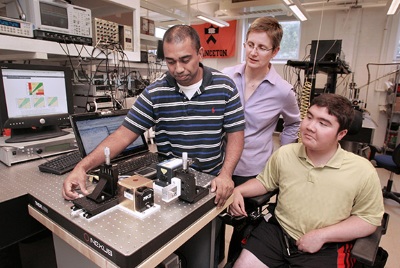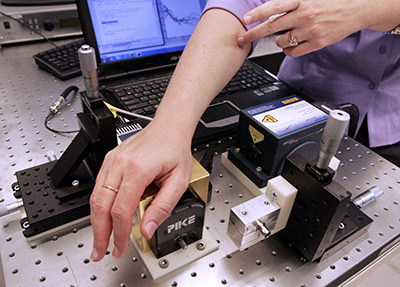Researchers at Princeton University have developed a device they believe will significantly improve the quality of life for individuals suffering from diabetes. The breakthrough is a laser system that can measure an individual’s blood sugar levels without there being any need to prick the person and draw blood.

The results of the research were published in the journal Biomedical Optics Express . In it, the researchers describe how they were able to measure a person’s condition simply by shining the laser into the individual’s palm: The laser passes through the skin cells without any resulting damage, and is partially absorbed by the sugar molecules in the person’s body. This tiny amount of absorption is then used to measure the level of blood sugar in the patient’s system.

Sabbir Liakat, the lead author of the article, said that everyone on the team was surprised by the accuracy of the technology. Where glucose monitors are required to produce a blood-sugar reading of at least 20%, the group’s system was far above this benchmark; the current model actually has an accuracy rating of 84%.
“It works now but we are still trying to improve it,” said Liakat, a graduate student in electrical engineering.
“This summer, we are working to get the system on a mobile platform to take it places such as clinics to get more measurements,” he adds. “We are looking for a larger dataset of measurements to work with.”
The success of this technology can largely be attributed to its use of a quantum cascade laser, a relatively new device that is particularly adept at producing mid-infrared lasers.
Mid-infrared light is important for two reasons: it’s not blocked by water, which is what the human body is mostly made up of, and it’s also not hindered by the acids and chemicals found in skin. The reason why it’s not used as often in medical technology nowadays is that it’s very difficult to produce with standard lasers. It also requires high power and stability in order to penetrate the skin and scatter off bodily fluid (this latter point is particularly important because the target is not the blood itself; rather, a fluid called dermal interstitial fluid, which contains within it a strong concentration of blood sugar).
The reason why standard lasers cannot achieve mid-infrared light with ease is that frequency depends on the material that makes up the laser. With a quantum cascade laser, however, electrons pass through a cascade of semiconductor layers; this, in turn, gives the user the ability to set the device to one of a number of different frequencies.
Such a high level of control allows users to then specify the frequency they want, including mid-infrared light. Recent improvements to the technology also provided for increased power and stability, which, in turn, allowed the Princeton researchers to penetrate a patient’s skin with a greater level of safety.
Speaking of the actual experiment, the group used the laser on three healthy people before and after they ate 20 jellybeans. They then measured their device’s results against those provided with a finger-prick test, and re-performed this test time and again over the course of several weeks.
The results of the experiments indicated that the laser produced average errors slightly larger than standard blood sugar monitors, but well within the clinical requirement for accuracy.
The group plans to work on ways to improve the system’s accuracy, and as mentioned earlier, the researchers will also focus on scaling the device down to the point that it’s easily portable for on-the-go diagnostics. They will also look into alternative uses for the technology.
“Because the quantum cascade laser can be designed to emit light across a very wide wavelength range, its usability is not just for glucose detection, but could conceivably be used for other medical sensing and monitoring applications,” Gmachl said.
Story via Princeton
Advertisement
Learn more about Electronic Products Magazine





